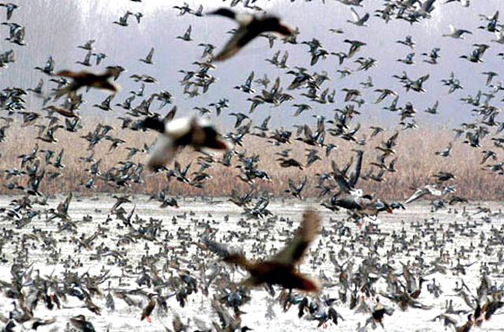Rubon Saproo
The good news for bird lovers, who like watching waterfowl, should visit the Kashmir valley in this winter season as around one million migratory birds of different species and colour have already arrived in the wetlands as usual after covering long distances from different parts of Siberia, Russia, China, North Europe and Middle East. The number shows that there is a considerable increase in the population of migratory birds despite claims of their decline figure in India due to rapid degradation of the environment.
These birds include Greyleg Geese, Brahminy Duck, Tufted Duck, Northern Pin-Tail, Gadwall, Northern Shoveller, Red Crested Pochard, Common Teal, Common Merganser, Mallard and some rare species, including a pair of Wigeon. These birds cover thousands of miles to come here and then, as winter ends, they once again return to their original habitat without making any mistake in the direction they have to take in their long flights.
“The migratory birds start arriving in the beginning of November and will stay till February-March, but this year they come earlier in the first week of October and with huge numbers. About, 4 lakh birds have landed in valley in the month of October and such record number of migratory birds has not been spotted in recent years during this period,” an official of Wetland Division Kashmir said. He also said that the number has touched now one million.
These winged visitors can be spotted by and large in every water body of Kashmir valley, however, flocks of these water birds are easily noticeable on the protected wetland conservation reserves like, Hokarsar, Hygam and Mirgund in Baramulla, Wular in Bandipora, Shallabugh in Ganderbal and Chatlum, Kranchu and Minibugh in Pulwama district.
One can see groups of Pintails who have arrived this year in large numbers than the usually dominated Mallards. There is a confusion to identify Mallards among domestic ducks in water bodies. Domestic ducks may lack white neck ring, show white on the chest, be all dark, or show oddly shaped crests on the head. Mallard is the ancestor of nearly all domestic duck breeds except Muscovy duck.
So far, over 300 protected species of avifauna have been recorded in Kashmir valley, including 18 species of ducks and equal number of threatened species where the exact numbers of endangered species are not known. Of the 300 bird species, about 50% are migratory and 50% resident birds. The famous wetland Hokarsar, which is about 13 Km from Srinagar, has become a paradise for migratory water birds during this winter as large numbers of waterfowl flock to the sanctuary. About, five lakh birds comprising of mainly Mallard, Northern Pintail, Common Teal and Garganey can be spotted on waters of Hokarsar. However, this number exceeds in the month of February when migratory birds from other places converge here before flying back to their original habitat.
The main reason for flock of water birds in such great number in Hokarsar is its unique feature of bird adaptation in winters. This wetland conservation reserve also provides a favourable habitat for both resident and migratory waterfowl. The lake offers suitable environment for different species during breeding cycles. These breeding species include Little Grebe, Little Bittern, Grey Heron, Night Heron, Little Egret, Water Rail, Common Moorhen and Pheasant-Tailed Jacana. Some birds depend on this wetland completely for breeding, feeding, resting and shelter where others use this wetland for their needs or they might use both wetland and upland habitats.
Hokarsar has been declared as ‘Ramsar Site’ in India during 2005 comprises Indian wetlands deemed to be of ‘International Importance’ under the Ramsar convention. Earlier, in the year 1945, Maharaja Hari Singh has notified it an important ‘bird sanctuary’ keeping in view of its unique habitat for birds.
Like Hokarsar, the birds also arrive in Wular Lake-Largest fresh water lake in India- in good numbers in winter days. This lake is considered to be the best staging ground for migratory waterfowl due to its hassle free environment, better protection and adequate food. But, the migratory birds have chosen the water body only for night stays and fly to other wetlands in the morning. The birds migrate at day due to interference of both human population and local birds. Hardly, few thousands of birds could be seen floating on and flying over the largest water body.
A good number of migratory birds also flock avian in Shallabugh, Hygam ,Mirgund, Chatlum, Kranchu and Minibugh wetlands besides in a reservoir of Lower Jhelum Hydro Power Project while the lakes of Manasbal , Anchar and Nageen also witness small flocks of water birds. However, thick population of these winged visitors can also be observed in world famous Dal Lake. It seems beauty has returned in these ‘dying’ wetlands the moment water fowls entered in their life. There is a buzz with birds chirping, cooing and fluttering. There are thousands of colourful water birds swimming gracefully on still and swampy waters. Visitors come here to watch these birds and they do not show any fright.
Migration is one of the most fascinating aspects of the avian world. They arrive in Kashmir to escape from harsh winters of their original habitats. The adverse conditions occurring in these sites followed by extreme cold and frozen water bodies which restrict their free movement compelled majority of birds to migrate. However, for all birds, it is believed that scarcity of food is one of the principle is driving forces behind their migration.
Unfortunately, many of the world’s migratory species are in decline, assailed by multiple threats, including habitat loss, unsustainable hunting, illegal poaching, climate change and diseases. But, for the safety of migratory birds, a state-level planning and efforts are needed to sensitize people on bird conservation.


